The Statue of Liberty Nebula is a large, bright emission nebula located approximately 9,000 light-years away in the constellation Carina. The H II region is roughly 100 light-years across. It has the designation NGC 3576 in the New General Catalogue.
NGC 3576 was named the Statue of Liberty Nebula because the shape of the clouds of dust and gas in its middle portion is reminiscent of the monument. The dense clouds absorb some of the light of the nebular material in the background. The name was originally suggested by Dr. Steve Mazlin of the Star Shadows Remote Observatory (SSRO), a remote observing group.
The complex shapes within the nebula are produced by the young stars that form inside the nebula’s clouds. The strong stellar winds from the embedded massive stars carve the surrounding clouds and filaments, producing the nebula’s unique appearance. The intense ultraviolet radiation of the young stars energizes the clouds of hydrogen, sulphur and oxygen, making them glow.
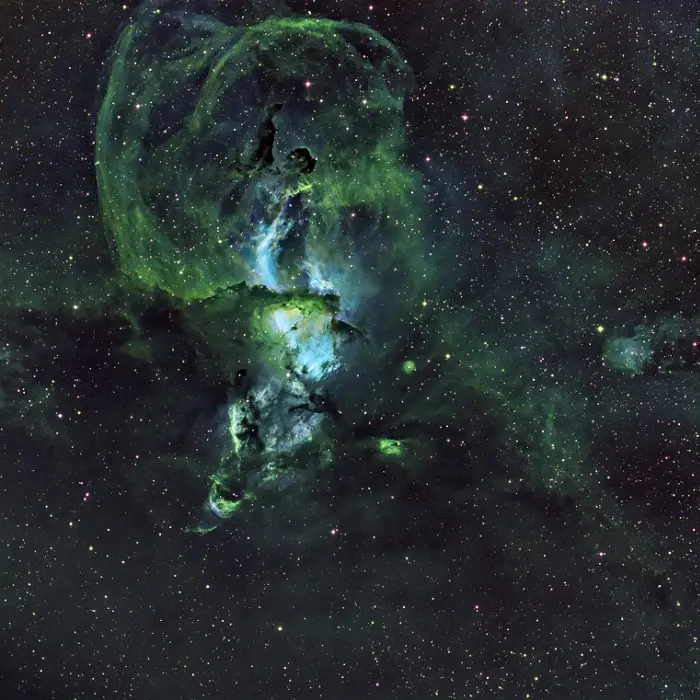
Statue of Liberty Nebula in Hubble Palette, image credit: Mark Johnston (CC BY-SA 4.0)
The Statue of Liberty Nebula appears close to the bright emission nebula NGC 3603 in the sky. However, the two nebulae are not physically related. NGC 3603 is a giant nebula located approximately 22,500 light-years away, at more than twice the distance of NGC 3576. It hosts some of the most massive and most luminous stars known in the Milky Way.
Facts
The nebula NGC 3576 was discovered by the English astronomer John Herschel on March 16, 1834. Herschel also discovered the nearby NGC 3603 two days earlier.
The Statue of Liberty Nebula lies in the Sagittarius Arm, a minor spiral arm of the Milky Way. The Carina-Sagittarius Arm of our Milky Way hosts many bright star-forming regions and young open star clusters. These include the Carina Nebula (NGC 3372) in the constellation Carina, the open clusters Messier 11 (the Wild Duck Cluster) and Messier 26 in Scutum and Messier 18 and Messier 21 in Sagittarius, and the emission nebulae Messier 17 (the Omega Nebula) and Messier 8 (the Lagoon Nebula) in Sagittarius and Messier 16 (the Eagle Nebula) in Serpens.
NGC 3576 and NGC 3603 are surrounded by several bright and well-known deep sky objects. They appear roughly halfway between the Eta Carinae Nebula (NGC 3372) in Carina and the Lambda Centauri Nebula (the Running Chicken Nebula, IC 2944) in Centaurus. The Wishing Well Cluster (NGC 3532), the Southern Pleiades (the Theta Carinae Cluster, IC 2602) and the Pearl Cluster (NGC 3766) appear in the same region of the sky. All these objects are listed in the Caldwell catalogue and can be observed in amateur telescopes.
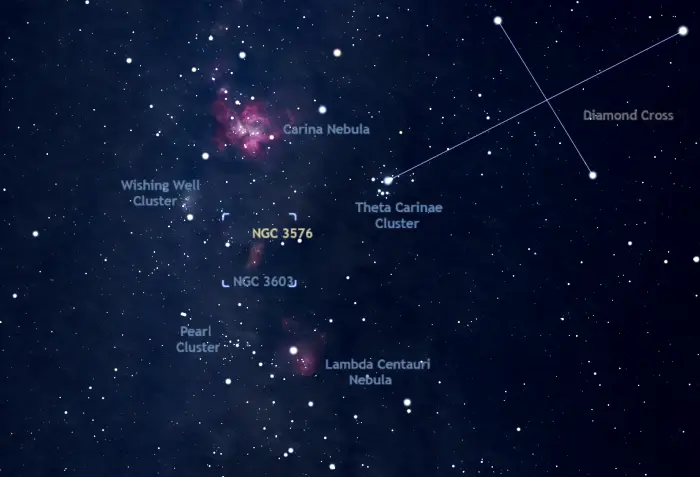
The Statue of Liberty Nebula (NGC 3576), NGC 3603, the Carina Nebula (NGC 3372), the Running Chicken Nebula (IC 2944), the Southern Pleiades (IC 2602), the Wishing Well Cluster (NGC 3532), and the Pearl Cluster (NGC 3766), image: Stellarium
The Statue of Liberty Nebula is much larger than the better-known Orion Nebula, which has a diameter of 24 light-years, but not quite as large as the Carina Nebula, which is 460 light-years across. If NGC 3576 were located at the Orion Nebula’s distance, it would have an apparent size of 4 degrees, corresponding to eight full Moons.
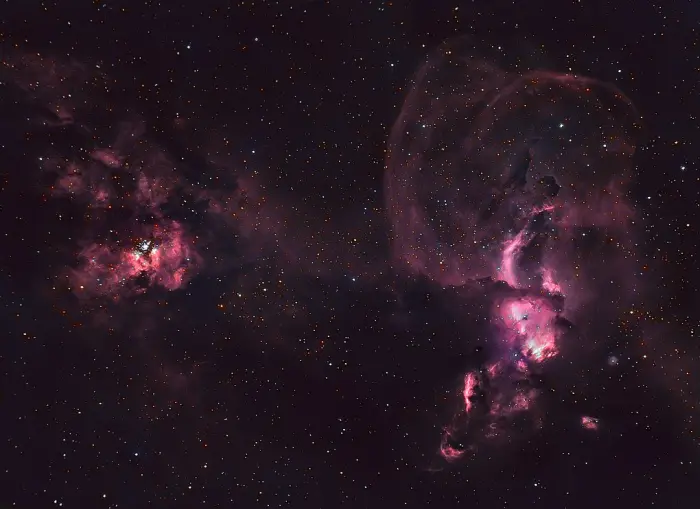
Statue of Liberty Nebula and NGC 3603, image credit: Dylan O’Donnell, deography.com (CC0 1.0)
Location
The Statue of Liberty Nebula lies in the southern constellation of Carina (the Keel). It can be found using the bright stars of the Diamond Cross, an asterism formed by Miaplacidus, Theta, Upsilon and Omega Carinae. A line extended from Miaplacidus through Theta Carinae leads to NGC 3567.
The Diamond Cross is the faintest of three diamond-shaped asterisms in the far southern sky. It appears in the region between the other two, the Southern Cross and the False Cross. The stars of the Diamond Cross can also be used to find the famous Carina Nebula, a vast stellar nursery that appears north-northwest of NGC 3576.
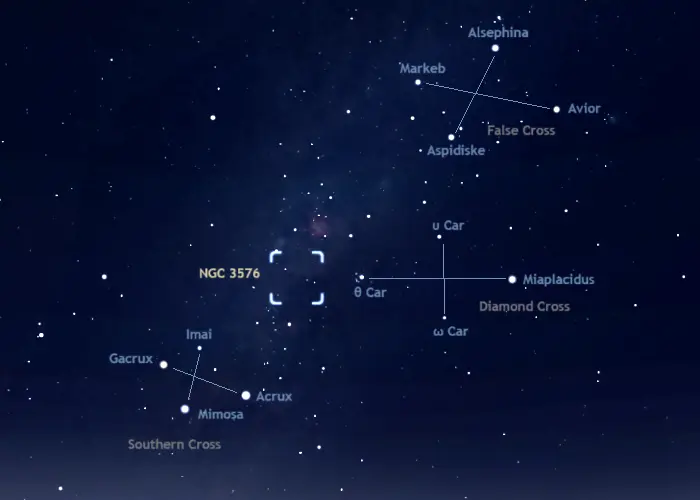
The location of the Statue of Liberty Nebula in Carina, image: Stellarium
At declination -61°, the Statue of Liberty Nebula never rises above the horizon for observers north of the latitude 27-28° N. It can only be seen low in the sky from northern tropical latitudes. For most observers in the southern hemisphere, the constellation Carina is circumpolar, and its stars and deep sky objects can be observed throughout the year.
The best time of the year to see the Statue of Liberty Nebula and other deep sky objects in Carina is during the month of March, when the constellation appears higher above the horizon in the early evening.
Statue of Liberty Nebula – NGC 3576
| Constellation | Carina |
| Object type | H II region |
| Right ascension | 11h 11m 32.7s |
| Declination | −61° 21′ 44″ |
| Distance | 9,000 light-years |
| Radius | 50 light-years |
| Names and designations | Statue of Liberty Nebula, NGC 3576, GUM 38a, RCW 57A, BRAN 348A, GAL 291.30-00.7, GAL 291.27-00.71, [GG70] 291.3-0.7, GAL 291.28-00.71, [GS70] 291.3-00.7 |
Images
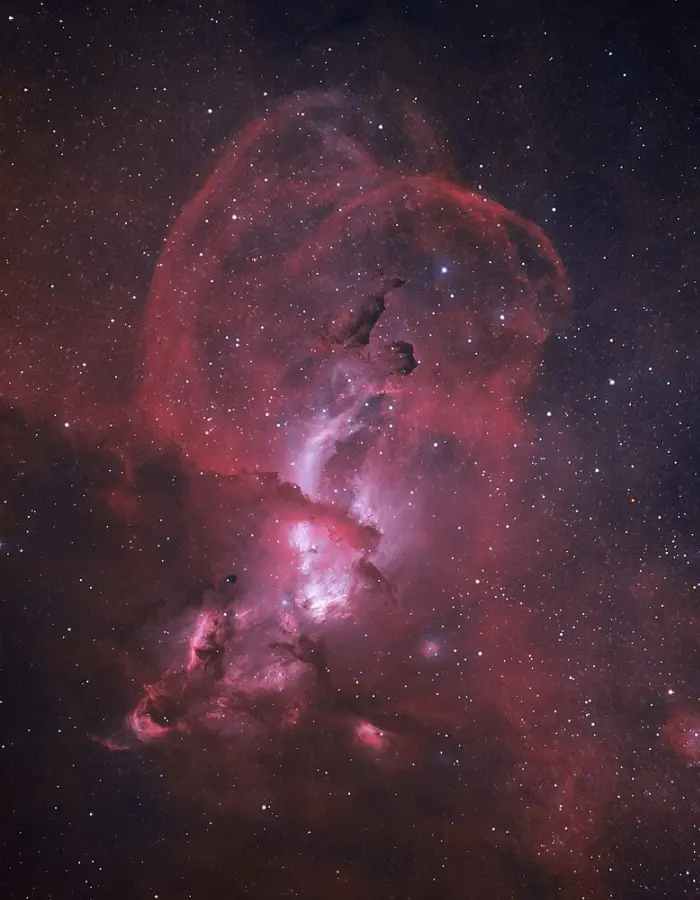
The Statue of Liberty Nebula (NGC 3576), image credit: Dylan O’Donnell (CC0 1.0)
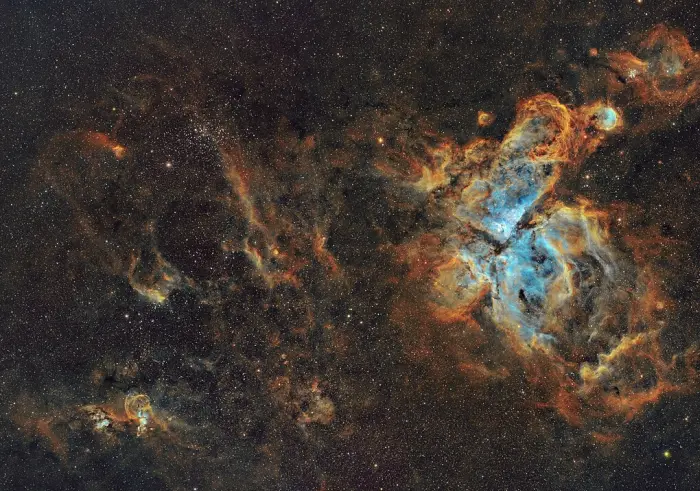
From NGC 3576 to NGC 3293 – 1×2 Mosaic in Hubble Palette. In this wide-field 1×2 mosaic we can see NGC 3576 (Statue of Liberty Nebula) in the lower left margin, the star cluster NGC 3532 (Wishing Well) in the upper left margin, and the Great Carina Nebula (NGC 3372) in the center, in the upper right margin the Gabriela Mistral Nebula (NGC 3324). and the Gem star cluster (NGC 3293). Image credit: Wikimedia Commons/Cappellettiariel (CC BY-SA 4.0)
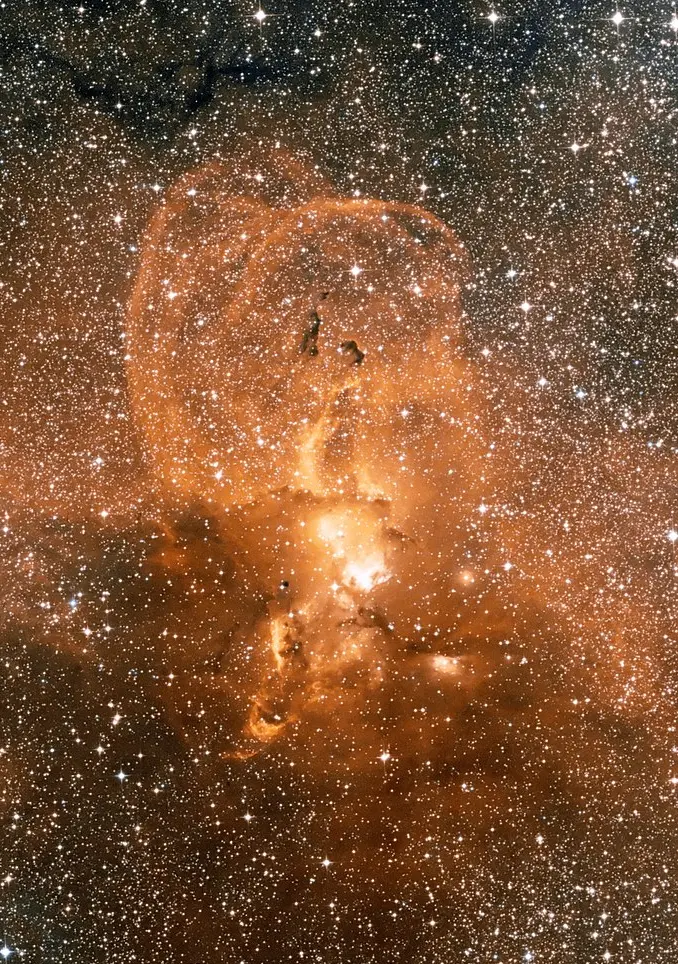
An image of NGC 3576 taken on the ground by the Digitized Sky Survey 2. The glowing clouds of hydrogen gas (seen here in orange) compose a vast emission nebula. The field of view is approximately 2.6 × 2.8 degrees. Image credit: NASA, ESA, and the Digitized Sky Survey 2 (CC BY 4.0)
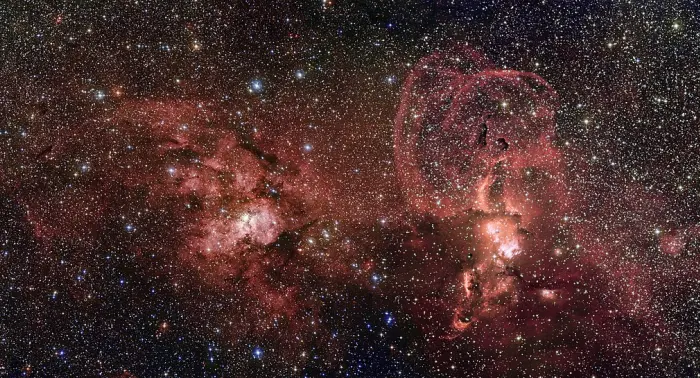
This image, captured by the Wide Field Imager at ESO’s La Silla Observatory in Chile, shows two dramatic star formation regions in the southern Milky Way. The first is of these, on the left, is dominated by the star cluster NGC 3603, located 20 000 light-years away, in the Carina–Sagittarius spiral arm of the Milky Way galaxy. The second object, on the right, is a collection of glowing gas clouds known as NGC 3576 that lies only about half as far from Earth. NGC 3603 is a very bright star cluster and is famed for having the highest concentration of massive stars that have been discovered in our galaxy so far. At the centre lies a Wolf–Rayet multiple star system, known as HD 97950. NGC 3603 is in an area of very active star formation. Stars are born in dark and dusty regions of space, largely hidden from view. But as the very young stars gradually start to shine and clear away their surrounding cocoons of material they become visible and create glowing clouds in the surrounding material, known as HII regions. NGC 3576, on the right of the image, also lies in the Carina–Sagittarius spiral arm of the Milky Way. But it is located only about 9000 light-years from Earth — much closer than NGC 3603, but appearing next to it in the sky. NGC 3576 is notable for two huge curved objects resembling the curled horns of a ram. These odd filaments are the result of stellar winds from the hot, young stars within the central regions of the nebula, which have blown the dust and gas outwards across a hundred light-years. Two dark silhouetted areas known as Bok globules are also visible in this vast complex of nebulae. These black clouds near the top of the nebula also offer potential sites for the future formation of new stars. Image credit: ESO/G. Beccari (CC BY 4.0)
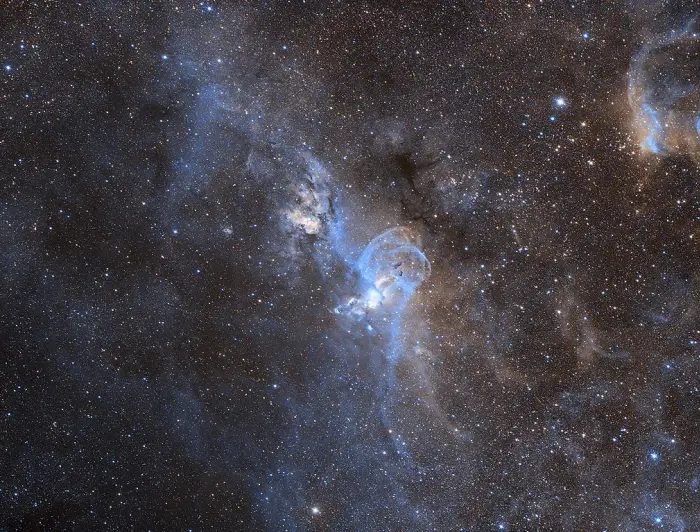
NGC 3603 and NGC 3576 – The Hydrogen-rich clouds (pictured in blue) stretch across the whole field of view with the secondary emission being the orange-brown folds of Sulphur. Dark dust regions obscure the view around the glowing star factory in the middle. Image credit: Dylan O’Donnell, deography.com (CC0 1.0)
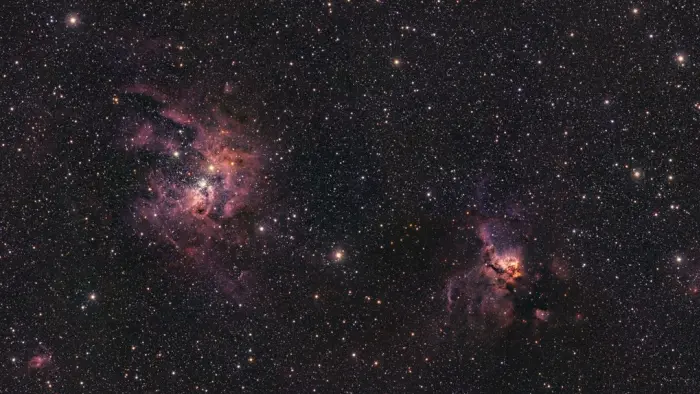
The image shows two cosmic clouds of purple with a golden orange glow towards their centres. The clouds are found separated from each other on each side of the image. The clouds stand out against a black background with a myriad of stars. This image shows a new view of NGC 3603 (left) and NGC 3576 (right), two stunning nebulas imaged with ESO’s Visible and Infrared Survey Telescope for Astronomy (VISTA). This infrared image peers through the dust in these nebulas, revealing details hidden in optical images. NGC 3603 and NGC 3576 are 22,000 and 9,000 light years away from us, respectively. Inside these extended clouds of dust and gas, new stars are born, gradually changing the shapes of the nebulas via intense radiation and powerful winds of charged particles. Given their proximity, astronomers have the opportunity to study the intense star formation process that is as common in other galaxies but harder to observe due to the vast distances. The two nebulas were catalogued by John Frederick William Herschel in 1834 during a trip to South Africa, where he wanted to compile stars, nebulas and other objects in the sky of the southern hemisphere. This catalogue was then expanded by John Louis Emil Dreyer in 1888 into the New General Catalogue, hence the NGC identifier in these and other astronomical objects. Image credit: ESO/VVVX survey (CC BY 4.0)
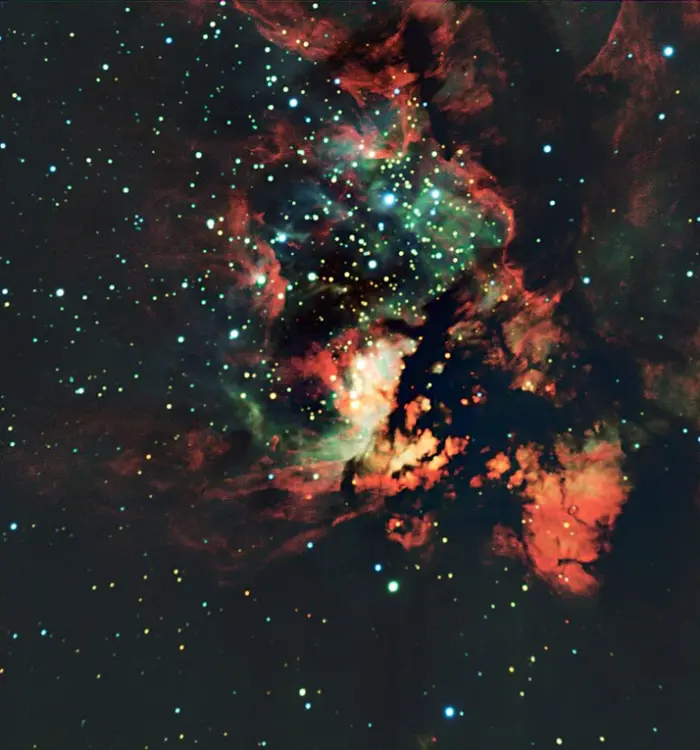
Located 9 000 light-years away, NGC 3576 is a gigantic region of glowing gas about 100 light-years across, where stars are currently forming. The intense radiation and winds from the massive stars are shredding the clouds from which they form, creating dramatic scenery. The black area in the right middle part of the image is dark because of the presence of very dense, opaque clouds of gas and dust. The data used to make this colour-composite images were taken with ISAAC on the VLT, in the framework of observing proposal 079.C-0203(A). The image processing was done by Yuri Beletsky (ESO) and Hännes Heyer (ESO). Image credit: ESO (CC BY 3.0)